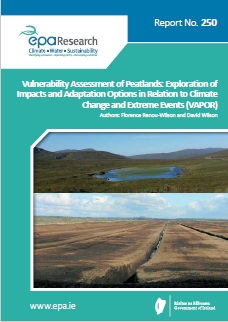Research 250: Vulnerability Assessment of Peatlands: Exploration of Impacts and Adaptation Options in Relation to Climate Change and Extreme Events (VAPOR)
Authors: Florence Renou-Wilson and David Wilson
Summary: The climate changes predicted for Ireland by the end of the 21st century will have significant impacts on drained, rewetted and natural peatland systems. The VAPOR project was established to inform a transition to a climate-resilient Ireland by providing science-based information on the vulnerability of peatlands to climate change, including extreme weather events.

Identifying pressures
Peatlands have played an important role in climate regulation over the past 10,000 years and the rewetting and restoration of peatlands has been demonstrated to offer considerable climate change mitigation opportunities. However, peatlands and organic soils in general are also vulnerable to climate change impacts and understanding and preparing for the effects of climate change – i.e. adaptation – is now seen as the overarching framework for conservation and land use management. The VAPOR project was established to inform a transition to a climate-resilient Ireland by providing science-based information on the vulnerability of peatlands to climate change, including extreme weather events. Long-term greenhouse gas monitoring studies over the last two decades have shown that Irish peatlands have been impacted by a wide range of environmental conditions. These studies provide robust greenhouse gas baseline data that can be used to better understand the effects of climate change on peatland ecosystems.
Informing policy
The results of the climate change simulation scenarios in this study highlight the extreme vulnerability of degraded (drained and rewetted) Irish peatlands to even modest changes in climate (i.e. 1–2°C increase in temperature, reduced summer precipitation). However, carbon dioxide (CO2) emissions from rewetted areas were lower than those from their drained counterparts, with some rewetted vegetation communities likely to remain sinks of atmospheric CO2 even with moderate climate changes. Drained agricultural peat soils are projected to become even greater hotspots of CO2 emissions.
It is likely that climate change will have significant impacts on all aspects of peatlands, but currently degraded peatlands are most at risk of desiccation, cracking and decomposition, leading to more carbon being released to the atmosphere and to waterways.
Rewetting was found to be a climate-proof, effective mitigation strategy, provided that extreme drying events like summer drought are not a more frequent occurrence. Importantly, the longer that a rewetted peatland is established, the more resilient it will be to climate change. A cost-effectiveness analysis supports early rewetting actions as an effective, low-cost
mitigation measure.
Developing solutions
With the observations highlighted by this research, it is strongly recommended that a national management plan is established to ensure that a sufficient range of natural and rewetted peatlands are properly managed to maintain the necessary water table levels that will sustain as many ecosystem services as possible. Secondly, drained peatlands used for agriculture and peat extraction should be targeted for rewetting as a climate change mitigation strategy to prevent increased greenhouse gas emissions in the future. Rewetting projects on cutover and cutaway sites (public-owned land) should be identified as a “low hanging fruit” mitigation measure.
https://www.epa.ie/media/epa-2020/publications/research/Research_250_thumbnail[1].jpg